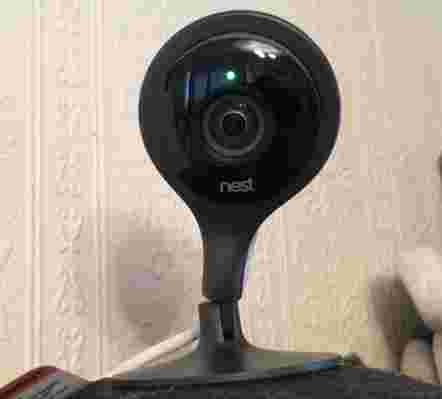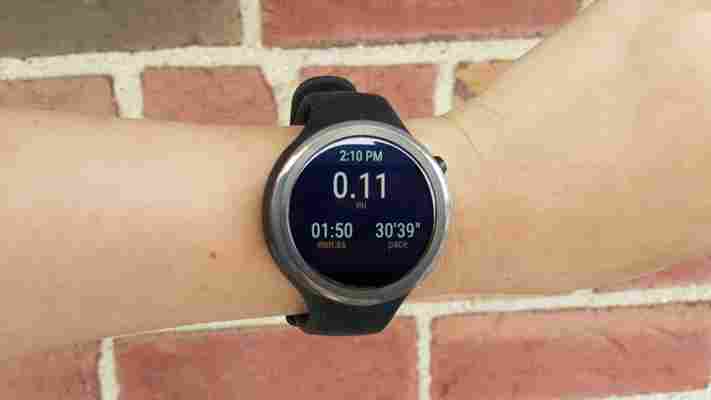This is Arashi.

She’s a beautiful shiba inu dog – smart, tenacious and loving, and she lives with me. But sadly, her tenacity got the best of her last week when she stole and ate some corn cob and needed surgery to get it removed from her stomach.
To help her recuperate, we set up a nice little bedding area, fenced off, where she wouldn’t get into trouble or overstrain herself while she healed.
Arashi’s ordeal happened in the same week as I received a Nest Cam to review, so I decided to put it to the test as a pet monitor.


Anyone who tried the old Dropcam devices ( acquired by Nest in June 2014) will know what to expect from the physical appearance of the Nest Cam – it looks very similar. It’s stylish enough to blend into most home surroundings and it’s smaller and heavier than I thought it would be.
It comes with a sticky pad to fix it to a wall or ceiling if you wish, but this requires some planning ahead, as you’ll need to contend with the USB power lead, which will need neatly tucking away somehow as it snakes its way to the nearest mains power socket. With this in mind, I just used it standing upright. Even in the unconventional position of sitting on top of a bowler hat on a shelf (which just happened to be the ideal place from which it could observe Arashi), it held steady thanks to its weight.
Nest Cam’s interface is the same iOS or Android app you’ll use if you own the company’s thermostat or smoke detector, and in fact the app made me feel like I was missing out by not having more Nest devices set up. If you do, you’ll benefit from integrations like automatically recording a video clip when smoke is detected.
If you have a Nest Aware subscription, starting at $10 per month, you can look back through an archive of video clips of up to 30 days. The subscription also enables features like ‘activity zones’ that restrict motion alerts to a small area of the camera’s field of view. Unfortunately, you’ll need to use the desktop browser-based Web app to do this, and it requires Flash to be installed ( ugh ).
The Cam works well as a pet monitor. By default, it shows a wide-angle view of the what’s in front of it, at 1080p resolution. Slightly freaked out that it was recording me sitting on my sofa working, I used the ‘Enhance’ feature to zoom in on Arashi’s pen. This refocuses the camera so that it only records that part of the room. That way, anyone else with my login could keep an eye on Arashi without getting a view of me tapping away on my computer.
When I had to go upstairs or into the kitchen, I’d keep the Nest App open on my phone to monitor Arashi. If she tried to take my absence as an opportunity to escape from her pen (shibas are natural escapologists ), I knew I’d be able to tell her off using the app’s microphone, which allows you to speak out of the camera using your phone’s microphone.
Arashi has been snoozing a lot during her recuperation, so I wanted to make sure I was notified when she woke up. I set up push notifications for movement detection (you can also set up sound notifications). Even when I was out of the house, I’d know she’d woken as my Apple Watch tapped my wrist to let me know. You can get normal notifications on your phone if you don’t have a smartwatch, or course.
If I missed the movement (generally just Arashi getting up to have a shake and a stretch before going back to sleep), I opened the ‘Highlights’ section of the app. That stores short video clips from the time of the alert, so you can see what happened.
Used to its full potential, Nest Cam could be a full home or small business security system. You could set up multiple cameras around your house and monitor them from your phone. Nest goes further than that though, it markets the Cam as a device to keep running all the time.
At its press launch in June, the Cam was presented as a camera you could run all the time to effortlessly capture important family moments. Didn’t get your phone out in time to record your baby’s first steps? Don’t worry – Nest has them stored on its servers!
Nest may be part of that many-tentacled techtopus Alphabet , but I’m not going to suggest there’s an Orwellian plot to monitor the whole population here. Still, leaving the Cam running all the time did make me feel just a little uneasy. I wasn’t doing anything untoward, but I still felt I had to be on my best behavior and not relax – I was potentially being watched.
In reality, it’s highly unlikely anyone other than the people you live with would ever be watching you (Nest plays up the security of its cloud platform), but even then the idea of always being ‘spied on’ in my own home, even by my own family, is enough to put me off trying everything the Nest Cam has to offer.
There are plenty of choices if you’re looking for a home security camera. We’ve previously reviewed the Canary , and just yesterday we highlighted the Butterfleye .
Personally, I’ve used the Withings Smart Baby Monitor in the past. I don’t have any children but it worked well as a pet monitor. Nest Cam is a cut above the Withings device. Its industrial design, the software, the image quality, cloud-based recording (which admittedly won’t be within everyone’s comfort zone) – this is a solid choice for keeping an eye on your home and I’ll be buying at least one.
I won’t be using every feature it has to offer, but as a pet monitor and home security camera I can plug in and use as needed, the Nest Cam has won me over.
As for Arashi? She’s recovering nicely – but we’ve banned sweetcorn from the house.
Check out this amazing manual for Atari arcade games from 1980
Atari, once the prosperous creator of popular arcade machines has mostly faded into irrelevance these days.

This beautiful, 186-page manual , for servicing your arcade machines is a peek into a different time, when Atari was at the top of its game.
Simply called “The Book” it’s an exhaustive, seven chapter manual, targeted at technicians for Atari’s coin-operated video and pinball machines.
According to the foreword in The Book , it’s not intended to make you a technician or turn you into an engineer, but it’s impressively detailed.
The manual features everything from how to use an Ohmmeter and soldering iron, to detailed exploding diagrams of the steering wheels and joysticks you’d probably recognize from your favorite old-school game.
There are even detailed schematics of how the internal boards of machines are wired, explanations of integrated circuits and insights into how binary works.
It’s probably well over your head — it’s over mine, by a mile — but it’s an incredible insight into the amount of work involved in keeping those machines alive.
The manual being publicly available could help enthusiasts that have purchased an old Atari unit for themselves maintain and repair them for long-term use.
➤ The Book [Text Files, via Hacker News ]
Image credit: Shutterstock
Moto 360 Sport review: If you haven’t bought it yet, you’re better off waiting
When Motorola announced the second generation of its Moto 360 smartwatch, it made it clear that the Sport edition would arrive several months later than the classic.

You’d think that it would use that extra time to truly fine-tune the runner-friendly version. After all, there’s several features worth waiting patiently for: Moto 360 Sport has a better display for outdoor use, built-in GPS, and a rubber strap to withstand all the sweating you’re theoretically doing while wearing it.
In practice, the smartwatch still seems a bit rushed out of production. Here’s what I mean.
Both the second-gen Moto 360 and its Sport edition have the same 1.37-inch screen with the flat tire (Motorola says this is necessary to get all the sensors in while maximizing a circular screen real estate). The crucial difference is Sport version uses a ‘hybrid’ display, which combines a traditional LCD screen with reflective panel so reading in the sun is an ease.
The Moto 360 Sport also as a unibody build of rubber straps. While this is great for repelling sweat, it’s not interchangeable, so you can’t customize your bands like the classic version. Personally, I think this makes the watch look a bit toy-like.
Weight-wise, the Sport feels just a hair heavier than the Moto 360 due to all the silicon rubber. The fit is better with the classic version, as I use a specifically-designed version sized for women.
Using the Moto 360 Sport outdoors is a dream. New York City hasn’t been getting a whole lot of sunny days, but when it is bright out, the display is easy to read without manual adjustment. It’s also not too glaring – I find most smartphones’ default backlight so insanely bright, it’s like staring into a lightbulb. The soft-lit but legible screen makes it great for those who run and want to glance at the time or their performance stats without taking a break.
Speaking of running, Moto 360 Sport’s key selling point is the built-in GPS which allows you to use it without pairing to your smartphone. It’s a feature most runners crave, so they can take the device and go without worrying about route-logging.
The watch comes with its Moto Body software as a standard feature, which is good for a quick look at your week’s activities, but you can download apps like RunKeeper , Runtastic , or Strava to get highly detailed logs. Otherwise, the watch features the fitness-themed face as the default so you can always check calories burned, heart rate and steps taken.
To track your exercises, a quick tap on the start button gets you on your way. In this mode, Moto 360 Sport tracks your running pace, distance travelled and running time. You can even look at your heart rate’s burn zone to make sure you’re not doing too little or too much, which is a neat feature.
Going out for a run without your smartphone is a freeing feeling, but it comes at a cost: battery life. I’ve used the second-gen Moto 360 for about three months before trying the Sport, and it normally lasts me almost two days before needing a charge. The Moto 360 Sport struggles to survive past a day, and it’s even worse if you leave GPS or always-lit screen mode on during exercise.
There are some battery-saving tools built-in, though. For example, the hybrid display for outdoor uses only kicks in when it’s needed instead of staying bright constantly. Still, at less than a day’s worth of battery life, it’s up to you to decide what’s more important – all-day use, or whatever the duration of your workout is.
While the GPS is accurate at estimating my whereabouts, sometimes it can misinterpret me roaming around my apartment. In several instances, the watch appears to think I’m walking around my block when I’ve just strolled to the front of my apartment and back, or when I’ve walked up and down three flights of stairs to pick up mail.
Oh, one last thing: don’t let the rubber watchbands fool you – this thing is not waterproof. It can handle a bit of sweat and maybe a run in light rain, but don’t expect to swim or take in the shower. It’s also sort of a dust magnet, so be mindful of that as well.
The Moto 360 Sport works well when used as intended, but poor battery life may prevent most people from making the investment just yet – especially when Mobile World Congress is just around the corner.
If you don’t mind recharging ever so often, or only wearing the watch when you go for long runs outdoors, this could be the device for you. But at $300 apiece, I anticipate a small percentage of users who’d be able to accept these limitations.
If you’re looking to get a good hybrid between a fitness tracker and a smartwatch, it’s best to wait at this point for upcoming announcements this year. Given that this is Motorola’s first true fitness smartwatch, this was to be expected – but with it doubling the second-gen Moto 360’s battery life from its predecessor, we think fall may be the time to watch for something truly remarkable.
Until then, sit tight… or go for a run sans-watch.
➤ Moto 360 Sport
